This small Java applet uses design rules according to [22],
[23], and [24],
to size a tuned pipe for a 2 stroke piston engine. The calculations are assuming
a speed of sound in the exhaust gas, which is not known exactly; also, it
depends on the temperature and thus on fuel/air mixture and external conditions.
In this applet, the gas conditions for methyl alcohol (methanol) and gasoline
have been implemented. The results of the calculations can be used as a good
starting point for experiments and fine tuning, deviations of +/-10% are surely
possible.
Typical exhaust gas temperatures (can vary strongly depending on exhaust
system and engine load):
| Gasoline |
750 ... 850 K |
500 ... 600 °C |
| Methanol |
450 ... 550 K |
200 ... 300 °C |
Usage
- Measure the timing of your engines exhaust and transfer
ports in degrees (see below).
|
- Measure the dimensions and calculate the area of the exhaust port
opening in the sleeve.
|
- Assume the velocity of rotation of your engine in rpm (dreaming
doesn't help much though).
|
- Either:
- use the sliders to adjust the values according to your engine, or
- enter the corresponding values into the text fields and press
[enter] to update the graph.
|
- Printing and Exporting only works, after you have
adjusted the appropriate Java security settings of your Internet Explorer
browser. If you use a different browser, you can run JavaPipe as a
standalone application which has access to files and printers (see below).
You could create a hardcopy of the program window, though, using your
systems suitable tools.
|
- You can manually plot the cones to build a paper model or to transfer
the shape onto sheet metal by using the values of R and phi
noted below each cone. Plot two concentric circles (having the same
center) using the two radii R. The flattened cone spans a segment with an
opening angle of phi degrees between the two circles.
|
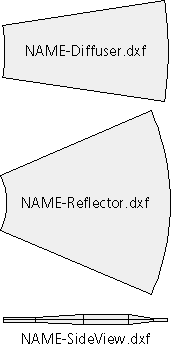 |
- The Print... command will print a copy of the general
arrangement and a scaled view of the cones on a single sheet as shown
below:
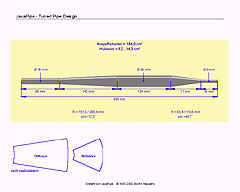
- The Export... command will create three AutoCad compatible
DXF files for the two cones plus a side view of the complete tuned pipe.
You specify a base file name and JavaPipe appends an extension as shown in
the picture to the left.
Later, you can import these into your favorite CAD program for printing or
further processing.
|
Determining the Timing
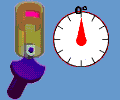
|
The animation shows, how to measure the timing angles of exhaust and
transfer port. These angles define how long the ports are open, expressed
in crankshaft angle. You can attach a disk with divisions in degrees to
the crankcase and a pointer to the crankshaft (or vice versa). See
also here.
Then you adjust disk and pointer so that the it indicates 180° when the
piston is at its bottom dead center. Now you turn the crankshaft until the
port of interest closes (when the piston crown arrives at the upper edge
of the port). It is helpful to point a flashlight or a halogen lamp
through the plug hole or to remove the cylinder head.
Reading the angles in both directions must be symmetrical to the bottom
dead center, e.g. a port opening at at 100° must be closing again at
360°-100° = 260°, as shown in the animation. The port timing angle (shown
in blue) is then 260° - 100° = 160°. This means, that port is open while
the the crankshaft turns 160°.
Usually the transfer port will have a shorter timing than the exhaust
port. |
Background
Used Formulas (a mixture from [22], [23],
and [24]):
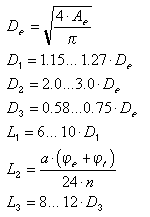
(metric units) |
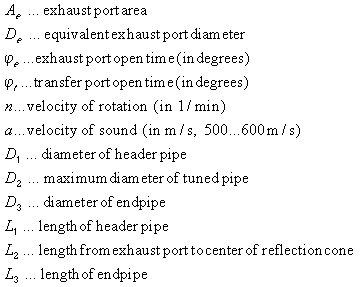 |
The opening angles of the cones should be 4° to 10° for the opening cone and
approximately twice this value for the closing cone.
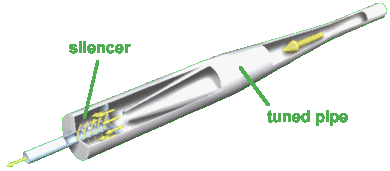
Cut view of a tuned pipe with silencer. |
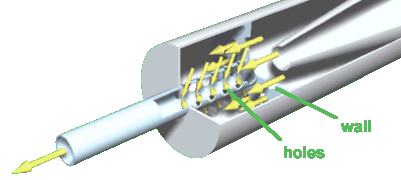
Enlarged view of the muffler section. |
see also:
F3D Pylon Racing Engines with some engines
optimized for tuned pipes,
Peter
Soule's documentation to learn more about the history of tuned pipes for
model engines,
my Silencer Application software, including a similar
tuned pipe designer.
How to download JavaPipe to use as a standalone Application
Remark: to use JavaPipe in the standard way in your browser, over
the internet, it is not necessary to perform the procedures described in this
section. I cannot give much support to solve any problems occurring while
running your local copy based on your local Java installation. If you have not
already a working Java system on your machine, you might want to consult a
computer guru.
If you want to run your local copy of JavaPipe , you can download a
copy of the JavaPipe archive to your disk. You can also save the applet page to
a local file, depending on the method you want to use for running you local
copy.
Step by Step Instructions to download the required files
- Check, whether you have a Java virtual machine (VM) installed on your
system.
- Open a command prompt (UNIX: shell or xterm window) and execute the
command java - version.
- If the command executes and displays something, you have a java
installation.
- Make sure that your Java version is 1.4.0 or above.
- If the version is lower than 1.4.0, you will have to get the appropriate
Java Runtime Environment (JRE) for your system from the web site
http://www.java.com.
- Download this html file from
- Download the .JAR archive version from:
- Create a subdirectory "java" below the directory, where you have copied
this html file and move the tunedpipe.jar file into this directory.
- Now you have both files to run JavaPipe either as an applet or a
standalone application. You can run the applet by loading this html page into
your browser or by using the AppletViewer.
[More details can be found here].
- To make life for Windows users even easier, you can also download the
Windows Installer file which contains all you need and installs JavaPipe
correctly. In fact this is probably the best way for Windows users.
To re-install or de-install use the "Software" applet inside the System
Control Program of Windows.
Last modification of this page:
21.05.18

[Back to Home
Page] Suggestions? Corrections? Remarks? e-mail:
Martin Hepperle.
Due to the increasing amount of SPAM mail, I have
to change this e-Mail address regularly. You will always find the latest version
in the footer of all my pages.
It might take some time until you receive an answer
and in some cases you may even receive no answer at all. I apologize for this, but
my spare time is limited. If you have not lost patience, you might want to send
me a copy of your e-mail after a month or so.
This is a privately owned, non-profit page of purely educational purpose.
Any statements may be incorrect and unsuitable for practical usage. I cannot take
any responsibility for actions you perform based on data, assumptions, calculations
etc. taken from this web page.
© 1996-2018 Martin Hepperle
You may use the data given in this document for your personal use. If you use this
document for a publication, you have to cite the source. A publication of a recompilation
of the given material is not allowed, if the resulting product is sold for more
than the production costs.
This document may accidentally refer to trade names and trademarks, which are owned by national or international companies, but which are unknown by me. Their rights are fully recognized and these companies are kindly asked to inform me if they do not wish their names to be used at all or to be used in a different way.
This document
is part of a frame set and can be found by navigating from the entry point at the
Web site http://www.MH-AeroTools.de/.
Impressum
Datenschutz






